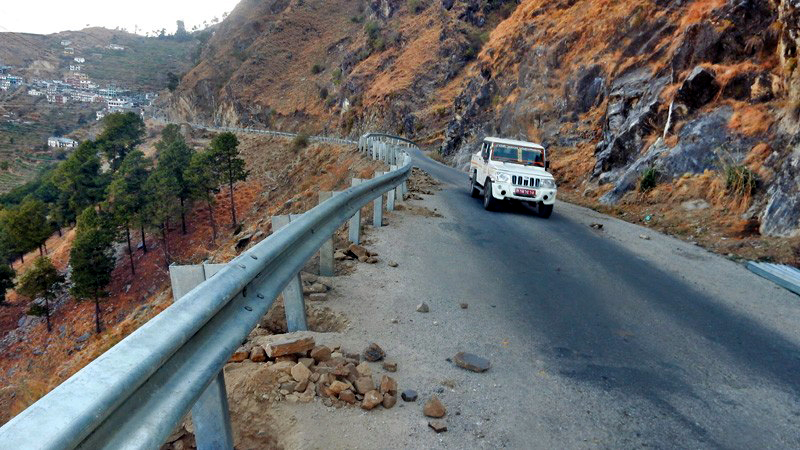Kalikot, February 23, 2017:Â Last Friday, Hari Bansha Acharya travelled to Kalikot to open a branch office of Sanima Bank in the district headquarters Manma by driving over Karnali Highway.
“I had read ‘Karnali Blues’, a novel by Buddhi Sagar about Karnali that was not connected by roads. But when I got here, I found that it was different; it is connected by roads now. Karnali Highway has greatly changed the district.â€
He praised the Nepal Army and the engineers who carved out a road through the hills for their hard work.
Following the opening of the highway, IME Bank, Sanima Bank and Tourism Development Bank have established branches in Manma. Before there was a road network, the only bank in the district was Rastriya Banijya Bank.
The 233-km Karnali Highway stretches from Bangesimal in Surkhet to Khalanga in Jumla. The highway is blacktopped and safety metal fences are now being installed on the sides.
The eight bridges on the highway, however, are not in a good condition as a result of careless construction by the workers.
After trucks and tractors started plying the highway, the mule caravans that used to plod over mountain trails to carry goods have become history.
The road has facilitated commercial agriculture too. “Highways have been a key component of development,†said Jagadish Shahi, a 72-year-old local political leader. “The face of Kalikot has changed dramatically in just 10 years, thanks to the highway.â€
According to Shahi, slated-roofed houses in Kalikot have been replaced by concrete homes. Even on the rough terrain of Manma, houses are being constructed of modern concrete. Till 10 years ago, all the houses in Manma had thatch, slate or tin roofs.
“People have started to dismantle their homes to build modern and concrete houses,†said Ain Bahadur Shahi, president of the Nepal Construction Entrepreneurs Association in Kalikot.
The trend has spread to villages like Hulma, Serighat, Tadi, Daha, Pili Pakha, Serawada, Bali, Juwitha Galje, Khallagad, Rachuli and Dhanada.
Likewise, the people are developing Pili as a tourist destination. A homestay facility for visitors travelling to Rara in Mugu district has been constructed in Pili. This year, locals have planted 2,500 saplings in Pili. A higher secondary school has also been built.
Karnali’s rural areas have become clean and hygienic due to the easy availability of cleaning tools. “Karnali Highway is the backbone of the development of Karnali,†said Krishna Prasad Acharya, member of the Karnali Development Commission. “The highway has opened the door to development.â€
Due to the highway, land and house prices in Jumla and Kalikot have skyrocketed. Kalu Prasad Upadhyay, a local of Manma, said that a land plot that used to cost Rs30,000 to Rs40,000 few years ago now costs Rs2 million to Rs3 million.
“Farmers now grow crops and vegetables on a commercial scale,†said Sunil Singh, an agriculture development officer. “In the past, farmers used to grow crops for their own consumption only.â€
Pari Lal Neupane of Sipkhana grows cardamom and vegetables. He earns about Rs1 million annually. Similarly, pomegranate cultivation has been started in Phukot, while farmers in Baratu and Sukatiya are growing oranges.
According to Neupane, villages like Phoi Mahadev, Rachuli, Chilkhaya, Odhanku, Chapre and Pakha have planted more than 100,000 apple saplings. These villages are turning into commercial agriculture areas.
Bimal Sahil, a young entrepreneur, said that hordes of people who had migrated to cities like Kathmandu, Nepalgunj and Surkhet have started to return to their villages. They are starting commercial agriculture and hospitality businesses.
An apple processing centre and brewery have been established in Jumla. A number of villages in Kalikot have chicken farms. There are seven chicken farms in Manma too.
By Tula Ram Pandey







